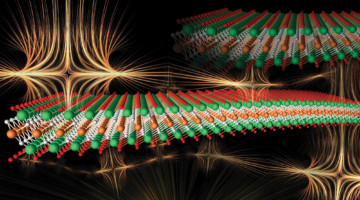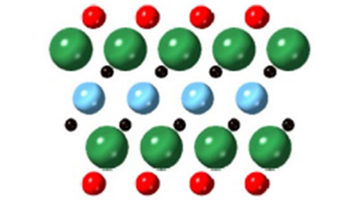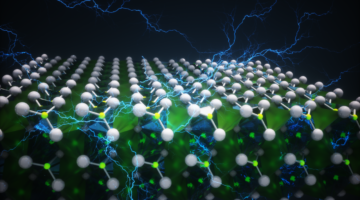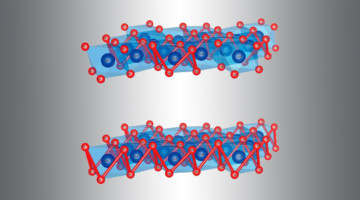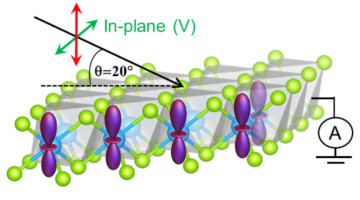A variety of experiments, including ALS x-ray studies, provided direct evidence of a magnetic transition in a 2D compound called a MXene (pronounced “maxene”). The finding adds new functionality to a family of materials with numerous ways to fine-tune properties for applications ranging from spintronic devices to electromagnetic shielding. Read more »![]()
![]()
ALS Work Using XAS
In x-ray absorption spectroscopy (XAS), the incident x-ray energy is tuned over a range that will excite core-level electrons. Sharp increases in absorption occur at specific energies, characteristic of the absorbing element. The resulting spectra probe the elemental composition as well as the chemical and electronic structure of the material.
Speeding Toward Improved Hydrogen Fuel Production
Researchers synthesized a material that speeds up one of the limiting steps in extracting hydrogen from alcohols. The catalyst cleanly and efficiently accelerates the removal of hydrogen atoms from a liquid chemical carrier. The material is robust, made from earth-abundant metals, and will help make hydrogen a viable energy source for a wide range of applications. Read more »
Scientists Design New Framework for Clean Water
A promising solution to water pollution from abandoned copper mines relies on materials that adsorb copper ions from wastewater, but commercially available products lack the required chemical specificity and load capacity. A team of scientists has designed a new crystalline material that targets and traps copper ions from wastewater with unprecedented precision and speed. Read more »
Understanding Electronic Structure in MXenes, One Atomic Layer at a Time
MXenes are 2D materials that can host a rich array of distinct chemical compositions that can be tuned for a broad range of applications, from energy storage to water purification. Site-specific x-ray absorption spectroscopy helped identify the unique roles of surface and subsurface transition-metal atoms in Ti-based MXenes. Read more »
Reversible Room-Temperature Fluoride-Ion Insertion in a Tunnel-Structured Transition Metal Oxide Host
Fluoride ions show promise as charge carriers in batteries but have limited cyclability. Here we show the reversible and homogeneous topochemical insertion/deinsertion and bulk diffusion of F ions within the one-dimensional tunnels of submicrometer-sized FeSb2O4 particles at room temperature. Read more »
Unexpected Rise in Ferroelectricity as Material Thins
Researchers showed that hafnium oxide surprisingly exhibits enhanced ferroelectricity (reversible electric polarization) as it gets thinner. The work shifts the focus of ferroelectric studies from more complex, problematic compounds to a simpler class of materials and opens the door to novel ultrasmall, energy-efficient electronics. Read more »![]()
![]()
The Bottleneck Step of a Complex Catalytic Reaction
The rate-limiting step in catalysis involving oxygen uptake was identified through analysis of the reaction pathways and observations performed under operating conditions. The work lays the foundation for improving the efficiency of energy conversion and storage devices such as fuel cells, catalytic reactors, and batteries. Read more »![]()
![]()
How a New Electrocatalyst Enables Ultrafast Reactions
With key data from the ALS, researchers discovered how a new, low-cost electrocatalyst enables an important oxygen reaction to proceed at an ultrafast rate. The work provides rational guidance for the development of better electrocatalysts for applications such as hydrogen-fuel production and long-range batteries for electric vehicles. Read more »![]()
![]()
Anomalous Orbital Structure in Two-Dimensional Materials
Researchers explored how structural distortions of the atomic lattice influence exotic electronic states in two-dimensional transition-metal dichalcogenides (TMDs). Polarization-dependent spectroscopy revealed an unexpectedly large crystal-field splitting of the valence electron states, a result of strong hybridization in metal–chalcogen orbitals. Read more »
Multimodal Study of Ion-Conducting Membranes
Using multiple x-ray characterization tools, researchers showed how chemical and structural changes improve the performance of a novel ion-conducting polymer (ionomer) membrane from 3M Company. The work provides insight into factors impacting the proton conductivity of ionomers used for fuel cells and the production of hydrogen fuel. Read more »![]()
![]()
- « Previous Page
- 1
- 2
- 3
- 4
- 5
- 6
- …
- 10
- Next Page »
